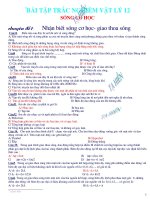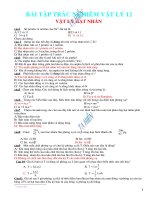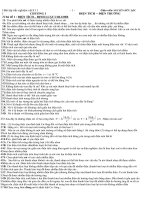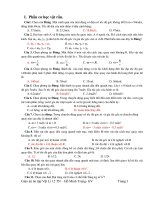Bài tập vật lí bằng tiếng anh
Bạn đang xem bản rút gọn của tài liệu. Xem và tải ngay bản đầy đủ của tài liệu tại đây (143.08 KB, 8 trang )
GV: Trần Danh Xuân Trường THPT Chuyên Quang Trung
Problem 1: (Chuyển động của vật trên mặt phẳng nghiêng)
A sled is a quick push up the snow slop. The sled slides up and then comes back down; the whole
trip take time t. If the coeffient of sliding friction between the sled and snow is
µ
, find the time tu it
took the sled to reach the top point of its trajectory. The slope makes the angle
θ
with horizontal.
Solution:
Newton’s second law applied ti the sled gives accelerations upwards (positive direction up) and
downwards (positive direction dow) as follows:
( )
sin
u
a g cos
θ µ θ
= − +
and
( )
sin
d
a g cos
θ µ θ
= −
If u and v are, respectively, the initial velocity when moving upwards and final velocity when
moving downwards, then according to the (constant acceleration) kinematical formula involving
squares of velocites, (try to prove this formula!). If tu and td are, respectively, the time it takes to
move down, then according to the definition of acceleration and using the privious equation. Combing
the latter equation with the first two, we get (noting that
tan
θ µ
>
since the sled comes back):
( )
1 (tan ) / tan
u
t
t
θ µ θ µ
=
+ + −
New Words:
• sled: xe trượt tuyết nhỏ
• slope: mặt phẳng nghiêng
• trip: hành trình
• coefficient: hệ số
• coefficient of slid friction: hệ số ma sát trượt
• to take time t: mất khoảng thời gian là t
• the top point: điểm cao nhất
• traejectory: quỹ đạo
• horizotal: (mặt phẳng) nằm ngang
• to make the angle: lập một góc
• law: đinh luật
• acceleration: gia tốc
• velocity: vận tốc
• initial (final) velocity: vận tốc ban đầu (cuối cùng)
• to move up (down): chuyển động đi lên ( đi xuống)
• according to: theo
• kinematical: (thuộc về) động học
• formula: công thức (số nhiều: formulae)
• square: bình phương
• equation: phương trình
• slide: trượt
• prove: chứng minh
• involve (+ing): bao gồm
Problem 2: (Bài toán ném xiên)
Figure (hình) 1 shows a pirate ship, moored(bỏ neo) 560m from a fort defending the harbor(bến
cảng, cảng) entrance(đi vào) of an island. The harbor defense cannon, located at sea level, muzzle
velocity of 82m/s.
a) To what angle must the cannon be elavated (độ nâng) to hit the pirate ship?
b) What are times of flight for the elevation angle calculated above?
c) How far should be pirate ship be from the fort if it is to be beyond(quá, vượt xa hơn) range of
the cannon balls?
Solution: As known, the equation of the trajectory of the ball is:
Bài tập tiếng anh Vật Lý Năm học: 2008 - 2009 Trang 1
GV: Trần Danh Xuân Trường THPT Chuyên Quang Trung
( ) ( )
2
2 2
0
tan 1
2
g
y X X
v cos
θ
θ
= −
Where
θ
is the elevation angle and v
0
is the muzzle velocity. To find the horizotal range of the ball,
let us X = R and y = 0 in Eq (1), after a little rearrangemant, obtaining(đạt được):
( )
2
0
.sin 2 2
v
R
g
θ
=
Soving Eq (2) for
θ
yields(giá trị)
0 0
2 2
0
560.9,8
sin 2 0,816 27 63
82
Rg
and
v
θ θ θ
→ = = = → = =
.
The commandent of the fort can elevate the guns to either of these two angles and hit the pirate ship.
b) As known, the horizontal position of the ball is given by the equation:
( ) ( )
0
3X v cos t
θ
=
Soving Eq (3) for t give, for
0
27
θ
=
,
0
0 0
560
7,7
82. 27
X R
t s
v cos v cos cos
θ θ
= = = =
Repeating the calculation for
0
63
θ
=
yields t = 15s. It is reasonable that the time of flight for the
higher elevation angle should be larger.
c) We have known that the maximun range corresponds to an elevation angle
θ
of 45
0
. Thus, from
Eq (2).
( )
2
2
0
0
82
sin 2 .sin 2.45 690
9,8
v
R m
g
θ
= = =
As the pirate ship sails away, the two elevation angle at which the ship can bi hit draw closer
togetther, eventually merging at
0
45
θ
=
when the ship is 690m away. Beyond that point the ship is
safe.
New Words:
• pirate: cướp biển
• (to) moor: neo
• Fort: pháo đài
• (to) defend: phòng thủ
• Cannon: pháo, đại bác
• Muzzle velocity: vận tốc đầu nòng (súng)
• Elevated angle: góc tầm (góc ngắm)
• (to) hit: trúng
• (the) commandant (of the fort): người chỉ huy (pháo đài)
• The time flight: thời gian bay
• Corresponds: tương ứng, đúng với, phù hợp với
Problem 3: (Bài toán tìm nhiệt dung riêng)
Two identical light metal containers are filled with equal amounts(lượng, số lượng) of water and
placed in a room with constant air temprature. A heavy ball is submerged(chìm, ngập dưới) into the
center of one of the containers on a thin nonconducting string. The mass of ball equals to the mass of
water, and the density of the ball is much greater than that of water.
Both containers are heated to the boiling point of water and are then allowed to cool. The container
with the ball in it takes k times longer to cool down to the room temprature than the container without
the ball. Find specific heat of the material of the ball C
b
in terms of k and the specific heat of water
C
w
.
Solution: The equation that relates the rate of heat flow to the temprature defferece is
( )
R
dQ
T T
dt
α
= −
Bài tập tiếng anh Vật Lý Năm học: 2008 - 2009 Trang 2
GV: Trần Danh Xuân Trường THPT Chuyên Quang Trung
Where T is current temperature of the container’s surface, T
R
is room temperature, and the constant
α
depends on the conductivity od the materials and the geometry of the container. The container. The
containers are identical so they should have the same constant
α
. After all, each container is made of
metal and conducts heat well, minimizing the discrepancy that results from the greater surface area of
the slingtly higher water level in the container with the submerged ball.
( ) ( )
( )
( )
.
R R
R
R
dQ
T T dQ T T dt
dt
dT
mcdT T T dt mc dt
T T
α α
α α
= − ⇒ = −
= − ⇒ =
−
The above equation shows that the time to cool to a temprature T is proportinonal to amount of heat
released by the container
( )
Q mc T= ∆
. Therefore,
b w w b
w w
mC T mC T C C
k k
mC T C
∆ + ∆ +
= ⇒ =
∆
And, finaly,
( )
1
b W
C k C= −
New Words:
• identical: đồng chất, giống hệt nhau
• light: nhẹ
• metal: kim loại
• temprature: nhiệt độ; the current temprature: nhiệt độ hiện thời
• nonconducting string: dây không dẫn (nhiệt)
• density: mật độ, khối lượng riêng
• boiling point: điểm sôi
• specific heat: nhiệt dung riêng
• to relate sth to/with sth: liên hệ cái gì với cái gì
• difference: hiệu
• to depend on: phụ thuộc vào
• minimizing: làm giảm thiểu
• discrepancy: sự khác biệt
• proportional (to): tỉ lệ thuận với
Problem 4: (Bài toán tìm thời gian nhỏ nhất)
A child in the boat needs to cross the river, the speed of current in river is k times greater than the
speed of the boat in the still water. If the child crosses the river such as to minimize the lateral
displacement, it takes time t to cross. What is the minimum time required to cross the river?
Solution:
The two sketches below show two possible directions for the resultant velocity of the child (v
1
at the
top sketche, v
2
at the bottom one). When the child chooses the direction
1
v
ur
(see top sketch), angle
α
is maximized, and she gets the minimum lateral displacement.
From the top sketch:
2
2
1 1 1
sin 1 1and cos k
k k k
α α
= = − = −
For the minimum time we find: d = v.t
min
For the minimum displacement, the distance traveled (let us call it l ) is given by d =
sinl
α
, and the
time required to cross with minimum lateral displacement is given by:
Bài tập tiếng anh Vật Lý Năm học: 2008 - 2009 Trang 3
GV: Trần Danh Xuân Trường THPT Chuyên Quang Trung
( ) ( )
1
.k vcos t l because v kvcos
α α
= =
Combining these equations gives:
min
.sin .t k cos
α α
=
, or:
2
min
1
.
k
t t
k
−
=
New Words:
• speed: tốc độ
• current: dòng nước (the speed of the current : tốc độ dòng nước)
• lateral displacement: độ dịch chuyển theo dòng nước (nghĩa trong bài)
• to minimize: làm (cho cái gì đó) đạt cực tiểu
• it takes time t… : mất thời gian t để …
• equation: phương trình
• sketch: hình vẽ
• resultant velocity: vận tốc tổng hợp
Problem 5 (Bài toán tìm ứng suất)
A balloom is fill with helium at the atmospheric pressure P. The volume of the balloon is V. The
balloon is made of the material of mass m and density d. After being released(làm nhẹ), the balloon
bursts at altitude where the atmospheric pressure is P/2. Immediatety before bursting, the balloon has
a volume of 1,25V. Find the maximum stress that the balloon material can withstand. Assume(cho
rằng) that the temprature of helium remains constant, the balloon remains spherical(hình cầu), and
the density of the material remains virtually(gần như, hầu như) constant.
Solition: Let us denote the final volume and pressure by V’ = 1,25V and P’, respectivity. Taking
helium to be an ideal(lí tưởng) gas, we can write that PV = P’V’ under isothermal(đường đẳng nhiệt)
conditions(điều kiện), so that P’ = 0,8P. Since the external(bên ngoài) is 0,5P, the net outward
pressure foce on half of the ballon is 0,3P. Thus(như vậy, do đó..) the net(tổng cộng) pressure force
on half of the balloon is
2
0,3 .P R
π
, where R is final radius of the balloon, given by
3
4
1,25
3
V R
π
=
.
But this must just balance(cân bằng) the elastic force
A
σ
∆
, where
2A Rt
π
∆ =
is the cross-sectional
area of the ballon material at its mid-plane. Here t is the thickness(độ dày) of th ballon material,
obtained(thu được) from
2
4
m
d
R t
π
=
. Combining(kết hợp) the equations givens:
9
16
PVd
m
σ
=
New Words:
• balloon: khí cầu
• pressure: áp suất (atmospheric pressure: áp suất khí quyển)
• material: vật liệu
• (to) burst: nổ
• density: mật độ hay khối lượng riêng
• atitude: độ cao
• volume: thể tích
• stress: ứng suất
• (to) wthstand: chịu được
• (to) remain: còn là
• net us denote ….. by…. : ta kí hiệu … là….
• the net outward pressure: áp suất tổng hợp hướng ra ngoài
• pressure fore: áp lực
• elastic fore: lực đàn hồi
• area: diện tích (cross-sectional area: diện tích tiết diện ngang)
• mid-plane: mặt phẳng giữa (đi qua tâm khí cầu)
Bài tập tiếng anh Vật Lý Năm học: 2008 - 2009 Trang 4
GV: Trần Danh Xuân Trường THPT Chuyên Quang Trung
Problem 6: (Bài toán về thấu kính – gương)
An eagle lands on the ground a = 5.00m behind a hiker’s back. The hiker sees two images of the
eagle refleting (phản xạ) in her glasses. One image appears to be b
1
= 5.00m away, and orther is b
2
=
0.714m away. When she turns and looks at the eagle, still wearing glasses, the image of the eagle
appears to be at a distance b
3
= 2.5m. Find the index of refraction n of the lenses.
Solution: Let us consider(xem xét) the first situation. Since one of images is 5.00m away, it is clear
that one of the lens surface is flat. For rays passing through such a lens, the lensmarker’s equation
givens:
1
1
R
f
n
=
−
Here R is the radius of curvature of the concave surface, n is the index of refraction of lens, ans f
1
is focal length of the lens.
Also, for a concave surface with radius R, the focal length f
2
can be found as:
2
2
R
f =
The rays from the object are passing through the lens, reflecting from the convex surface, and
passing through the lens again to emerge from the flat side to form a virtual image:
( )
2 1 2 1 1 2
2 1
1 1 1 1 1 2 1 2 2
n
n
a b f f f f f R R R
−
− = + + = + = + =
When the hiker turns, the rays from the object passing through the lens also form a virtual image:
3 1
1 1 1 1n
a b f R
−
− = =
Eliminating R from the pair of equation,
( )
5
1 5
3
n n
− =
÷
, so n = 1.5.
New Words:
• eagle: đại bàng
• (to) land: đậu
• round: mặt đất
• hiker: lữ khách
• image: ảnh (virtual image: ảnh ảo)
• glasses: kính mắt (wearing glasses: đeo kính)
• (to) reflect: phản xạ
• index of refration: chiết suất
• lens ( số nhiều: lenses): thấu kính
• radius of curvarture: bán kính cong
• concave surface: mặt lõm
• convex surface: mặt lồi
• focal length: tiêu cự
• ray: tia sáng
• passing through: truyền qua
• (to)emerge: ló ra
• (to) elimilate: khử, loại bỏ.
Problem 7: (Dao động cơ học)
When the system shown in the diagram is in equilibrium,
the right spring is stretched by X
1
. The coefficient of the
static friction the blocks is
s
µ
; there is no friction between
the bottom block and the supporting surface. The force
Bài tập tiếng anh Vật Lý Năm học: 2008 - 2009 Trang 5









